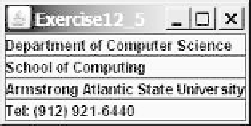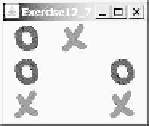Java Reference
In-Depth Information
10.
You can specify the horizontal and vertical text position relative to the icon in
JButton
,
JCheckBox
,
JRadioButton
, and
JLabel
.
T
EST
Q
UESTIONS
P
ROGRAMMING
E
XERCISES
Note
The image icons used in the exercises can be obtained from
www.cs.armstrong.edu/liang/intro9e/book.zip
under the image folder.
download image files
Sections 12.2-12.6
12.1
(
Use the
FlowLayout
manager
) Write a program that meets the following
requirements (see Figure 12.26):
Create a frame and set its layout to
FlowLayout
.
■
Create two panels and add them to the frame.
■
Each panel contains three buttons. The panel uses
FlowLayout
.
■
F
IGURE
12.26
Exercise 12.1 places the first three buttons in one panel and the other three
buttons in another panel.
12.2
(
Use the
BorderLayout
manager
) Rewrite the preceding program to create
the same user interface, but instead of using
FlowLayout
for the frame, use
BorderLayout
. Place one panel in the south of the frame and the other in the
center.
12.3
(
Use the
GridLayout
manager
) Rewrite Programming Exercise 12.1 to add six
buttons into a frame. Use a
GridLayout
of two rows and three columns for the
frame.
12.4
(
Use
JPanel
to group buttons
) Rewrite Programming Exercise 12.1 to create the
same user interface. Instead of creating buttons and panels separately, define a
class that extends the
JPanel
class. Place three buttons in your panel class, and
create two panels from the user-defined panel class.
12.5
(
Display labels
) Write a program that displays four lines of text in four labels, as
shown in Figure 12.27a. Add a line border around each label.
(a) (b) (c)
F
IGURE
12.27
(a) Exercise 12.5 displays four labels. (b) Exercise 12.6 displays four icons.
(c) Exercise 12.7 displays a tic-tac-toe board with image icons in labels.







